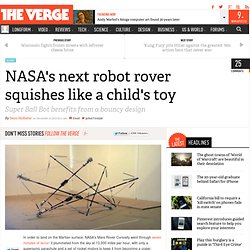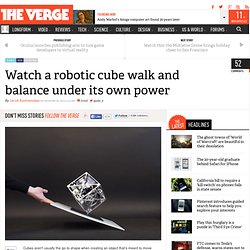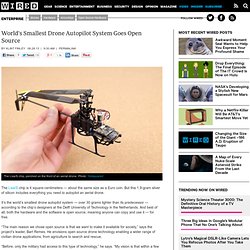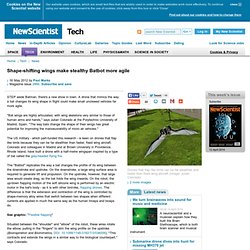

NASA's next robot rover squishes like a child's toy. In order to land on the Martian surface, NASA's Mars Rover Curiosity went through seven minutes of terror: it plummeted from the sky at 13,000 miles per hour, with only a supersonic parachute and a set of rocket motors to keep it from becoming a crater.

However, a team at NASA has a nifty trick up its sleeves for the next time around: a rover made of hollow rods and elastic cable that can squish and bounce. Just like the Skwish, a popular child's toy developed in the early '80s, NASA's Super Ball Bot uses the principles of tensegrity to do its job. The contraption can absorb the impact of a hard landing, pop right back up, then roll across a surface, end over end, like an extremely awkward ball. While NASA scientists are still proving that the concept works and figuring out the best way to control it as it rolls, they currently believe they could hang a payload inside the contraption and drop it onto a planet with little damage at all.
A kinder, gentler robot is coming. Jump To up down Close Andy Marchese has a lot of fish tanks but no fish food — his fish prefer batteries and compressed air.

Scientists just created some of the most powerful muscles in existence. Robotics. Free/Open Hardware Robot Projects. Watch a robotic cube walk and balance under its own power. Cubes aren't usually the go-to shape when creating an object that's meant to move around, but researchers in Switzerland have created one that can do just that — along with a handful of other surprising talents.

Called the Cubli, it measures nearly 6 inches on each side and can walk around by continually flipping itself over. Perhaps more impressively, it can also balance on any of its sides or even just a single corner. As the research team from ETH Zurich's Institute for Dynamic Systems and Control demonstrates in a video, the cube can even remain balanced while a surface is raised up at an angle beneath it. Similar to how satellites are stabilized in space Though it's a moving cube, the Cubli still relies on a series of spinning wheels to get going.
An insect-like, crash-happy flying robot. DIY Drones. Protei. >> 2013/04/25, 08:00 : Barcelona, Spain>> 2013/04/18, 08:00 - April 21, 20:00 : Casablanca, Morroco>> 2012/04/06, 08:00 - April 10, 20:00 Tema (Accra), Ghana>> 2013/03/25, 08:00 - March 30, 20:00 : CAPE TOWN, SOUTH AFRICA>> 2013/03/08, 08:00 - March 18, 20:00 : Port Louis, Mauritanie>> 2013/03/06 08:00 - March 11, 20:00 : Cochin, India>> 2013/03/01, 20:00 - Feb 25, 08:00 : Rangoon, Burma>> 2013/02/20, 08:00 - Feb 21, 20:00 : Singapore>> 2013/02/12, 08:00 - February 18, 16:00 : Ho Chi Minh, Vietnam>> 2013/02/07, 08:00 - Feb 8, 20:00 : Hong Kong>> 2013/02/03 : 08:00 - Feb 4, 20:00 : Shanghai, China>> 2013/01/30, 08:00 - Jan 31, 20:00 : Kobe, Japan>> 2013/01/27, 08:00 - Jan 28, 23:00 : Yokohama, Japan >> 2013/01/15, 08:00 - 16, 20:00 : Hilo, Hawaii, USA>> 2013/01/9, 17:00 : departure from San Diego, CA, USA >> 2012/11/29 : TEDxVilaMada "Nosso Planeta Agua" Sao Paolo, Brasil >> 2012/10/18 - 28 : Protei at Lodz Design Festival, Poland.

Blog Origin of the name & Biomimicry Protei Community. World's Smallest Drone Autopilot System Goes Open Source. The Lisa/S chip, perched on the front of an aerial drone.

Photo: 1bitsquared The Lisa/S chip is 4 square-centimeters — about the same size as a Euro coin. But this 1.9-gram sliver of silicon includes everything you need to autopilot an aerial drone. It’s the world’s smallest drone autopilot system — over 30 grams lighter than its predecessor — according to the chip’s designers at the Delft University of Technology in the Netherlands. And best of all, both the hardware and the software is open source, meaning anyone can copy and use it — for free. “The main reason we chose open source is that we want to make it available for society,” says the project’s leader, Bart Remes. “Before, only the military had access to this type of technology,” he says. Remes says he’s been flying remote-controlled aircraft since he was six years old. “At university, a lot of students are working in a compute simulation and never see the real world,” Remes says. The Lisa/S chip. Pop-up Fabrication of the Harvard Monolithic Bee (Mobee)
Electronic whiskers could give robots an ultra-fine sense of their environment. Whether you think about it or not, your skin is constantly feeding you information about your surroundings: how strong the wind is blowing, or if you are brushing against a wall.

For many animals, whiskers augment these sensations, and can also help animals locate objects, navigate through water and more. Robots, it turns out, would also benefit from having whiskers. Researchers want robots to sense their environment as realistically as possible, and relying on sight isn’t always enough. Robots might need to know the texture of an object or how firmly they can grasp it before it breaks.
Or they might need to know how fast the wind is blowing to calculate the best way to open a door. Electronic whiskers, revealed today by University of California-Berkeley and Lawrence Berkeley National Laboratory researchers, could be a solution. The whiskers are made of elastic fibers covered in carbon nanotubes and silver nanoparticles. Shape-shifting wings make stealthy Batbot more agile - tech - 30 May 2012. STEP aside Batman, there's a new show in town.

A drone that mimics the way a bat changes its wing shape in flight could make small uncrewed vehicles far more agile. "Bat wings are highly articulated, with wing skeletons very similar to those of human arms and hands," says Julian Colorado at the Polytechnic University of Madrid, Spain. "The way bats change the shape of their wings has great potential for improving the manoeuvrability of micro air vehicles. " The US military - which part-funded this research - is keen on drones that flap like birds because they can be far stealthier than faster, fixed wing aircraft. BionicOpter. With the BionicOpter, Festo has technically mastered the highly complex flight characteristics of the dragonfly.

Just like its model in nature, this ultralight flying object can fly in all directions, hover in mid-air and glide without beating its wings. Inspired by nature: the complex wing-flapping principle of the dragonfly ... ... technically achieved for the first time with the BionicOpter from Festo Free movement: even the most complex flight manoeuvres ... … can be performed easily and intuitively.
The Simplest Drone Of All Time? Following 100 years of flight, drones are making us question everything we know about aircraft.

Watch robot arms massage a roll of metal into a Tesla Model S. Robot Makers Spread Global Gospel of Automation. Sally Ryan for The New York Times A robot designed by Rethink Robotics to work with people.

An industry group said increased automation would lead to millions of new jobs by 2020. Well, that wasn’t actually the word used this week at the Automate 2013 trade show held here through Thursday, but the sentiment was the same. During a presentation on Monday, Henrik I. Christensen, the Kuka Chair of Robotics at Georgia Institute of Technology’s College of Computing, sharply criticized a recent “60 Minutes” report on automation that was based on the work of the M.I.T. economists Andrew McAfee and Erik Brynjolfsson.
The two economists in 2011 wrote “Race Against the Machine,” a book that renewed the debate about the relationship between the pace of automation and job growth. During his talk, Dr. “We see today that the U.S. is still the biggest manufacturing country in terms of dollar value,” Dr. “Automation has allowed us to compete on a global basis. Mr. Mr. Foxconn Considering Accelerated Transition to Robot Workers. Chinese manufacturer Foxconn may do its part to hasten the arrival of the robo-calypse as it considers scaling up introduction of a robot work force that some pundits believe could become cheaper than human workers by 2014.
The 21st Century Business Herald spoke with manufacturing analysts and experts that identified the year 2014 as a possible inflection point for Foxconn when the costs of robot-driven manufacturing will have dropped below those of human labor. Last year, Foxconn CEO Terry Gou outlined an ambitious plan to ramp up from 10,000 robots to 300,000 this year and a total of 1 million by 2014. Considering that the company employed 1 million workers in mainland China at the time of the announcement, the project’s scale would presumably replace a significant portion of its workforce. Foxconn’s move toward automated manufacturing has been partly driven by accidents that took place at its facilities. “I’ve seen the improvements that have been made, and they’re dramatic. Industrial robots: Baxter gets to work. Study: Humans and Robots Should Swap Jobs. An Android You Can Make With A 3D Printer. In no small part exacerbated by having a girl close to the same age, I tear up every time I see this video.
It's nice seeing technology as an implementation of our moral selves, and not simply a manifestation of our hubris or destructive tendencies. Well, I'd like to think there's just the tiniest shade of defiant hubris in this though. The most realistic female android ever! Creepily realistic robot can hold conversations and answer questions.
HRP-4C Miim dance demonstration. DARPA Building Real Life Terminators Military Robots. Shoot to Kill: Autonomous Robots Developed By DARPA Will Not Question Orders. Susanne Posel Occupy Corporatism September 4, 2012 The Defense Advanced Projects Research Agency (DARPA) Autonomous Robotic Manipulation (ARM) program seeks to find ways to utilize different remote robotic manipulation systems that are controlled by humans. Super-Robot With Twin Guns Is Unveiled. A massive robot that can carry a seated human pilot - and is armed with twin gatling guns - has gone on show in Japan. Kuratas is described as the world's first giant boarding robot, no doubt inspired by the "mechs" of Japanese anime and manga comic book culture which features human controllers inside a walking vehicle.
But Kuratas is different in that it offers two types of control system. The robot can be piloted directly, or remotely by a user connected to a 3G device such as a latop, tablet or smartphone. The firm that made the robot, Suidobashi Heavy Industry, even released a tongue-in-cheek video showing how to operate the robot. It was unveiled to the world at the Wonder Festival in the Tokyo suburb of Chiba. Kuratas, which is referred to as the Vaudeville project in a promotional video, has two humanoid arms and four wheeled legs - and twin six-barrelled gatling guns - which fire BB-sized pellets at the rate of 6,000 rounds per minute.